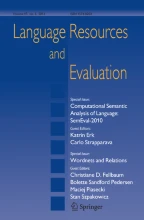Abstract
Wordnets have been created in many languages, revealing both their lexical commonalities and diversity. The next challenge is to make multilingual wordnets fully interoperable. The EuroWordNet experience revealed the shortcomings of an interlingua based on a natural language. Instead, we propose a model based on the division of the lexicon and a language-independent, formal ontology that serves as the hub interlinking the language-specific lexicons. The ontology avoids the idiosyncracies of the lexicon and furthermore allows formal reasoning about the concepts it contains. We address the division of labor between ontology and lexicon. Finally, we illustrate our model in the context of a domain-specific multilingual information system based on a central ontology and interconnected wordnets in seven languages.
Similar content being viewed by others
Notes
We will reserve the legally registered name “WordNet” for the Princeton WordNet and use “wordnet” as a generic term to denote semantic networks inspired by the Princeton WordNet.
In languages whose writing systems do not separate lexical units, the notion of word is of course divorced from that of a graphemic unit.
A small number of salient and possibly universally lexicalized roles, including mother, father, friend will be included in the type hierarchy.
References
Fellbaum, C. (Ed.). (1998). WordNet: An electronic lexical database. Cambridge, MA: MIT Press.
Fellbaum, C. (Ed.). (2007). Collocations and idioms: Corpus-based linguistic and lexicographic studies. Birmingham, UK: Continuum Press.
Fellbaum, C., & Miller, G. A. (2003). Morphosemantic links in WordNet. Traitement automatique de langue, 44(2), 69–80.
Fellbaum, C., & Vossen, P. (2007). Connecting the universal to the specific. In T. Ishida, S. R. Fussell & P. T. J. M. Vossen (Eds.), Intercultural collaboration: First international workshop (Vol. 4568, pp. 1–16). Lecture Notes in Computer Science, Springer, New York.
Gangemi, A., Guarino, N., Masolo, C., & Oltramari, A. (2003). Sweetening WordNet with DOLCE. AI Magazine, 24(3), 13–24.
Gruber, T. R. (1993). A translation approach to portable ontologies. Knowledge Acquisition, 5, 199–220.
Guarino, N., & Welty, C. (2002a). Identity and subsumption. In R. Green, C. Bean, & S. Myaeng (Eds.), The semantics of relationships: An interdisciplinary perspective. Dordrecht: Kluwer.
Guarino, N., & Welty, C. (2002b). Evaluating ontological decisions with ontoclean. Communications of the ACM, 45(2), 61–65.
Levin, B. (1993). English verb classes and alternations: A Preliminary investigation. Chicago, IL: University of Chicago Press.
Miller, G. A. (Ed.). (1990). WordNet. Special Issue of the International Journal of Lexicography, 3(4).
Miller, G. A. (1995). WordNet: A lexical database for English. Communications of the ACM, 38, 39–41.
Miller, G. A., & Hristea, F. (2006). WordNet nouns: Classes and instances. Computational Linguistics, 32(1), 1–3.
Moropa, K., Bosch, S., & Fellbaum, C. (2007). Introducing the African languages WordNet. In Proceedings of ALASA, Pretoria, South Africa.
Niles, I., & Pease, A. (2001). Towards a standard upper ontology. In Proceedings of FOIS-2 (pp. 2–9). Maine: Ogunquit.
Niles, I., & Pease, A. (2003). Linking lexicons and ontologies: Mapping WordNet to the suggested upper merged ontology. In Proceedings of the international conference on information and knowledge engineering (pp. 5–6).
Pala, K., Bosch, S., & Fellbaum, C. (2008). Building resources for African languages. In Proceedings of the sixth international language resources and evaluation, Marrakech, Morocco.
Pease, A., & Fellbaum, C. (2009). Formal ontology as interlingua. In C. R. Huang & L. Prevot (Eds.), Ontologies and lexical resources. Cambridge: Cambridge University Press.
Robkop, K., Thoongsup, S., Charoenporn, T., Sornlertlamvanich, V., & Isahara, H. (2010). WNMS: Connceting the distributed Wordnet in the case of Asian WordNet. In The 5th international conference of the global WordNet association (GWC-2010), Mumbai, India.
Ruppenhofer, J., Baker, C. F., & Fillmore, C. (2002). The FrameNet database and software tools. In A. Braasch & C. Povlsen (Eds.), Proceedings of the tenth Euralex international congress (pp. 371–375), Copenhagen, Denmark.
Sinha, M., Reddy, M., & Bhattacharyya, P. (2006). An approach towards construction and application of multilingual Indo–WordNet. In Proceedings of the third global wordnet conference, Jeju Island, Korea.
Tufis, D. (Ed.). (2004). The BalkaNet project. Special Issue of the Romanian Journal of Information Science and Technology, 7(15).
Vossen, P. (Ed.). (1998). EuroWordNet. Dordrecht: Kluwer.
Vossen, P., & Fellbaum, C. (2009). Universals and idiosyncrasies in multilingual wordnets. In H. Boas (Ed.), Multilingual lexical resources. Berlin: de Gruyter.
Vossen, P., & Rigau, G. (2010). Division of semantic labor in the global wordnet grid. In P. Bhattacharya, C. Fellbaum & P. Vossen (Eds.), Proceedings of the 5th global WordNet conference. Narosa Publishing House.
Vossen, P., Peters, W., & Gonzalo, J. (1999). Towards a universal index of meaning. In Proceedings of ACL-99 workshop, siglex-99, standardizing lexical resources (pp. 81–90). University of Maryland, College Park, MD.
Vossen, P., Agirre, E., Calzolari, N., Fellbaum, C., Hsieh, S.-K., Huang, C.-R., et al. (2008). KYOTO: A system for mining, structuring, and distributing knowledge across languages and cultures. In Proceedings of LREC, Marrakech, Morocco.
Acknowledgments
The work described here was funded by the European Union FP7 ICT Work Programme, Project ICT-211423.
Author information
Authors and Affiliations
Corresponding author
Rights and permissions
About this article
Cite this article
Fellbaum, C., Vossen, P. Challenges for a multilingual wordnet. Lang Resources & Evaluation 46, 313–326 (2012). https://doi.org/10.1007/s10579-012-9186-z
Published:
Issue Date:
DOI: https://doi.org/10.1007/s10579-012-9186-z
